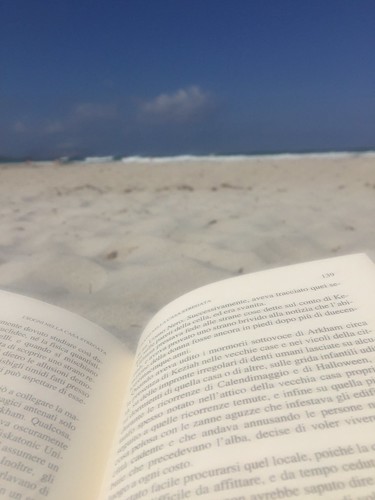 |
| Lovercraft and the power of sun cream to enhance photography |
The first thing I put in the suitcase were the books. Then the knitting projects.
What can I say? No matter the defects I have as individual, when it comes to packing I got my priorities straight.
So, armed with 4 books and 2 1/2 knitting project I felt quite ready for the holidays and only later asked myself: “what else should I pack?"
Ah yeah, all the rest, like swimming costumes, clothes, sun creams and whatever else it’s needed for 2 weeks at the seaside! But, after all, that’s what last minute preparation is for, right?
To start my holiday on a light note, I put Lovercraft’s short stories collection in the carry-on bag. It wasn’t planned, more of a very last minute impulsive shopping. Saturday before leaving I saw this book being sold for 3,9 euro.
— Note: here’s a small detour-rant on the topic of price tagging —
The price tag has a gigantic bold 3, while the “,90” bit is printed at almost micron font size, giving you the impression that the cost of the book is only 3€ rather than 4. And you might say: well, it’s only 4€, what’s the problem with you?
The problem is not the price itself, but rother it is printed to trick your mind into believing it’s 3 rather than 4. I wouldn’t get upset if all the digits were the same size or if the decimal digits didn’t require a magnifying lens to be read. Just be fair and state the price without subterfuge. Also, becuase this is the kind of purchase I use as a way of getting rid of all my pocket change, and I don’t enjoy to realize when I’m about the front of the queue that I don’t have the exact change. Damn! It means I have to scavange hunt for the remaining 90 cents, while the queue of Milanese customers growing restless and upset. Have you ever seen a Milanese person forced to wait because the person in front in the line is obviously hopeless and clumsy? In case you haven’t, call yourself lucky: they do love to make you feel like the lowest form of life ever to walk the earth.
So genius of marketing make the genius move of advertising the right prize on the book front cover.
— End of rant, oh I feel so much better now —
Now, back to Lovercraft: I briefly debated whether or not to buy the book, as I’m already running low on shelf space and anyway I would have to wait to be back from holiday to start reading the book.
The shelf space issue was immediately resolved with the idea of visiting Ikea again over the autumn and as for waiting for starting reading the book, then notion laster around 150 mt, the distance from the book shop to the bus stop. As I ended up halfway through the second story, I had no other option but carrying it with me.
Lovercraft makes for a weird summer read, because of the sharp contrast between the stories themes and styles, mainly set in cold months and the sun beating down, the blue sky and the quiet Sardinian sea. Yet, it seemed to me that the contrast accelerated my reading because I was done in less than 2 days, which is even more astounding given that on the first few days of holiday i slept most of the time.
Second book to go for sand bath treatments (the sand was so thin it managed to get everywhere and I fear the books I brought with me will spit sand out for the next 12 months) was “Justinian’s Flea” by William Rosen. What better way to spend a day at the sea with a lot of minuscule forms of life than reading of the devastating effects of Yersinia pestis on the Roman Empire?
Because the author is neither a scientist nor a historian, he offers a different approach; yet, since he worked in publishing houses for many years, he knew he had to do his homework when it came to bibliography and researches for the book.
Reading about history is fascinating to me because it’s like watching a domino show: you can concentrate on a single tile if you want but you risk of missing the whole effect. On the other hand, if you just look at the show as a whole, you miss the fine details and the importance of how and where tiles are placed. It’s a tough job to write about history, because aside the big and small picture, the writers should also make it nice to read: it’s not an easy task altogether as most of my high school and Univeristy history text can prove.
When I bought the book I was more interest in the Roman history side but the part I “enjoyed" more was the 3rd section of the book where Morris goes over in great details about the (hi)story of the bacterium: I’m not really interested in microbiology, but the fact that in the boot it’s put into a narrative way, it makes for a brilliant read and I found I could easily visualize how the bacterium work. It’s an horror I found more scaring than Lovercraft.

No comments:
Post a Comment